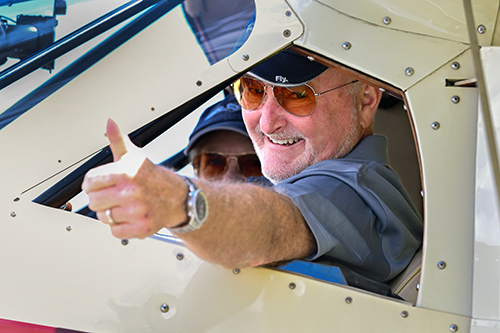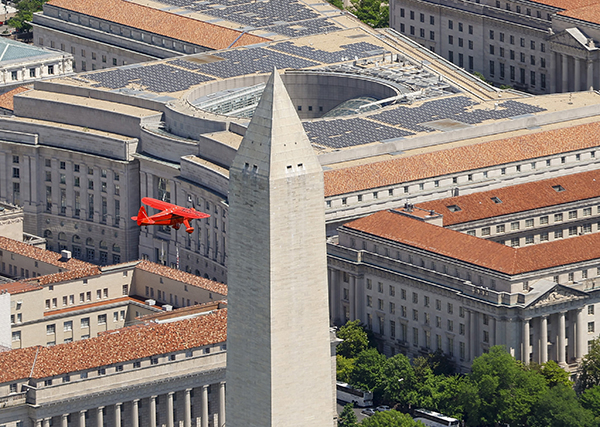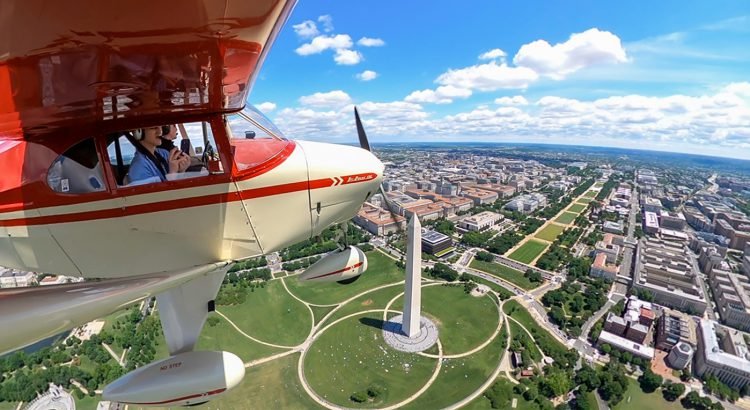AOPA photo above – David Tullis in a Piper Tri-Pacer.
When the Beechcraft Model 17 Staggerwing took off from Frederick Municipal Airport on Saturday—after 16 months of planning, intense coordination with 11 government agencies, focused pilot preparation, and closely watching the weather radar—a wave of excitement, pride, and relief washed over the general aviation community.

The National Celebration of GA D.C. Flyover featured 55 aircraft flying over the National Mall and some of the most prominent D.C. monuments. The flyover comprised 15 different “chapters,” telling the story of general aviation in the United States, from the Golden Age and general aviation after World War II, to the general aviation trainer era, vertical flight, backcountry flying, seaplanes, corporate and business aviation, technically advanced aircraft, homebuilt aircraft, airshow performers, and other examples of general aviation aircraft that support public service missions.
“From start to finish, this special event could not have been more amazing,” said Mike Ginter, AOPA Vice President of Airports and State Advocacy, and event “air boss.” “I can’t thank enough the countless people who made this day happen—from the team at AOPA to our government partners, sponsors, and all of the pilots and aircraft owners who gave of their time and aircraft. And best of all, the weather was as spectacular as the event.”
The special event took place over one of Washington, D.C.’s most restricted flight zones, Prohibited Area P-56, something that’s never been done with general aviation aircraft since September 11, 2001.
AOPA President Mark Baker led the flyover in his Staggerwing, which represented the Golden Age category.
“Wow. That was amazing. I want to thank the entire group for its commitment and time over the last year and pulling this incredible event together,” he said. “People have volunteered their airplanes, their fuel, and their time, so I want to give a big thanks to them. And the agencies—they were so excited about this special day. A lot of people came together and worked hard to make the flyover something special.”

Even the most seasoned and celebrated aviators marveled in the once-in-a-lifetime opportunity.
“It was great, it was flawless from my standpoint,” said Bill Finagin, pilot of the Pitts S2C—which flew in the Airshow Spectacle chapter. “Very-well organized,” Brad Kline piped in, who flew with Finagin and owns the aircraft.
Rusty Herrington, who flew the 1946 North American Navion in the Post-War Boom chapter, said the flyover was “a wonderful experience.” He highlighted how rare this opportunity was. “A new perspective, that you only get on television, we get it firsthand,” said Herrington.
Dave Hirschman, AOPA Pilot Editor at Large, flew a Van’s RV-4 in the Homebuilt category and participated in one of only two formation flights within the flyover, alongside two Van’s RV-8 aircraft. He spoke to the novelty of the experience. “It was so unusual because I’ve spent a lot of time flying in this region in the last 15 years and yet I have never flown in that airspace in that position,” he said. “It’s so close but it felt so foreign because it was all so novel.”



